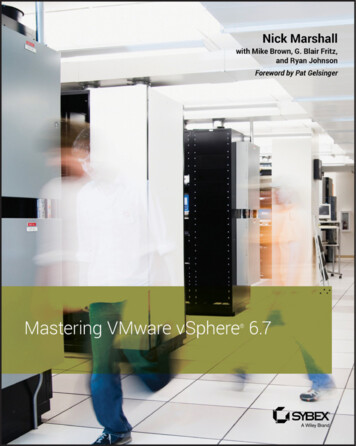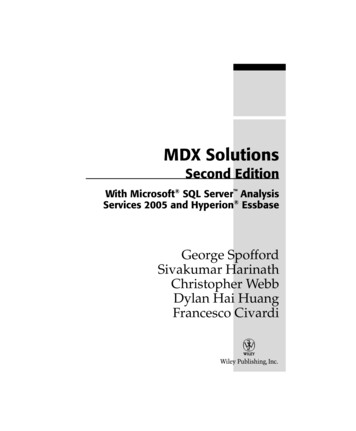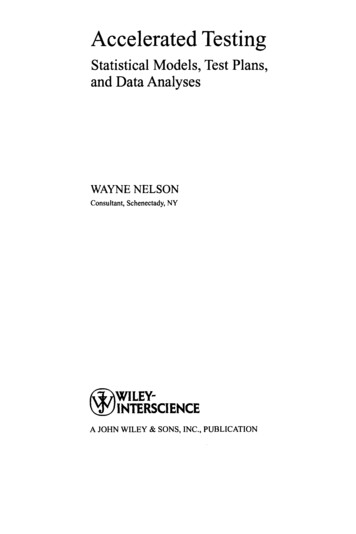
Transcription
CLINICAL PHARMACOLOGYAND THERAPEUTICSLecture NotesLNGerard A. McKayMatthew R. Walters9th Editionwithextendedmaterialonline'
Clinical Pharmacology and TherapeuticsLecture Notes
Clinical Pharmacologyand TherapeuticsLecture NotesEdited byGerard A. McKayBSc (Hons) FRCPConsultant Physician and Honorary Clinical Associate ProfessorGlasgow Royal Infirmary and University of GlasgowMatthew R. WaltersMD FRCP MScProfessor of Clinical PharmacologyDirector, Clinical Pharmacology and TherapeuticsInstitute of Cardiovascular and Medical SciencesUniversity of GlasgowNinth EditionA John Wiley & Sons, Ltd., Publication
This edition first published 2013 2013 by John Wiley & Sons, Ltd.Previous editions 1982, 1985, 1989, 1992, 1996, 2001, 2006, 2010Wiley-Blackwell is an imprint of John Wiley & Sons, formed by the merger of Wiley’s globalScientific, Technical and Medical business with Blackwell Publishing.Registered office: John Wiley & Sons, Ltd, The Atrium, Southern Gate, Chichester, West Sussex,PO19 8SQ, UKEditorial offices: 9600 Garsington Road, Oxford, OX4 2DQ, UKThe Atrium, Southern Gate, Chichester, West Sussex, PO19 8SQ, UK111 River Street, Hoboken, NJ 07030-5774, USAFor details of our global editorial offices, for customer services and for information about how toapply for permission to reuse the copyright material in this book please see our website atwww.wiley.com/wiley-blackwell.The right of the author to be identified as the author of this work has been asserted in accordancewith the UK Copyright, Designs and Patents Act 1988.All rights reserved. No part of this publication may be reproduced, stored in a retrieval system,or transmitted, in any form or by any means, electronic, mechanical, photocopying, recording orotherwise, except as permitted by the UK Copyright, Designs and Patents Act 1988, without the priorpermission of the publisher.Designations used by companies to distinguish their products are often claimed as trademarks. Allbrand names and product names used in this book are trade names, service marks, trademarks orregistered trademarks of their respective owners. The publisher is not associated with any product orvendor mentioned in this book. This publication is designed to provide accurate and authoritativeinformation in regard to the subject matter covered. It is sold on the understanding that thepublisher is not engaged in rendering professional services. If professional advice or other expertassistance is required, the services of a competent professional should be sought.Library of Congress Cataloging-in-Publication DataLecture notes. Clinical pharmacology and therapeutics / edited by Gerard A. McKay,Matthew R. Walters.—9th ed.p. ; cm.Clinical pharmacology and therapeuticsIncludes bibliographical references and index.ISBN 978-1-118-34481-1 (pbk. : alk. paper)I. McKay, Gerard A. II. Walters, Matthew R. III. Title: Clinical pharmacology and therapeutics.[DNLM: 1. Pharmacological Phenomena. 2. Drug Therapy. 3. Pharmacology, Clinical. QV 37]615’.1—dc232012044843A catalogue record for this book is available from the British Library.Wiley also publishes its books in a variety of electronic formats. Some content that appears in printmay not be available in electronic books.Cover image: Jan Mika/iStockCover design by Grounded Design Set in 8.5/11pt Utopia Std by Aptara Inc., New Delhi, India1 2013
ContentsContributors, vi14 Drugs and the urological system, 178Preface, vii15 Cancer therapeutics, 185Foreword, ix16 Drugs and inflammatory joint disease, 19717 Immunopharmacology, 204Part 1 Principles of clinicalpharmacology18 Drugs and the blood including anticoagulants andthrombolytic drugs, 21519 Drugs used for pain relief and anaesthesia, 2281 Pharmacodynamics and pharmacokinetics, 32 Clinical trials and drug development, 11Part 2 Aspects of therapeutics3 Drugs and gastrointestinal disease, 194 Management of coronary artery disease and itscomplications, 295 Primary and secondary prevention of cardiovasculardisease, 52Part 3 Practical aspects of prescribing20 Clinical pharmacokinetics: dosageindividualisation, 24121 Influence of renal and hepatic disease onpharmacokinetics and pharmacodynamics, 24722 Prescribing for the young and the elderly, 25223 Drugs in pregnant and breastfeedingwomen, 2556 Drugs used to treat respiratory disease, 7124 Pharmacoeconomics: the economic evaluation ofnew drugs, 2627 Drugs used to treat neurological disease, 8125 Poisoning and drug overdose, 2698 Treatment of psychiatric disorders, 9726 Drugs you may need in a hurry, 2839 Antimicrobial therapy, 11127 Prescribing and its pitfalls, 28710 HIV and antiretroviral treatment, 13211 Travel medicine and tropical disease, 143Self assessment questions, 29412 Drugs and endocrine disease, 153Self assessment answers, 29913 Drugs and the reproductive system, 169Index, 302
ContributorsThe following have contributed substantially to thewriting, revision and rewriting of the chapters for thisninth edition.Claire Higgins School of Medicine, University ofGlasgowChapter 13, Drugs and the reproductive systemPeter Higgins Institute of Cardiovascular and Medical Sciences, University of GlasgowChapter 1, Pharmacodynamics and pharmacokineticsPrabhakar Rajan Institute of Cancer Sciences,University of GlasgowChapter 14, Drugs and the urological systemJesse Dawson Institute of Cardiovascular and Medical Sciences, University of GlasgowChapter 2, Clinical trials and drug developmentBeth Reed NHS Greater Glasgow and ClydeChapter 3, Drugs and gastrointestinal diseaseShona Jenkins NHS Greater Glasgow and ClydeChapter 4, Management of coronary artery diseaseand its complicationsChapter 5, Primary and secondary prevention ofcardiovascular diseaseCharles Gourlay University of EdinburghChapter 15, Cancer therapeuticsIslay Morrison NHS Greater Glasgow and ClydeChapter 16, Drugs and inflammatory joint diseaseJagtar Nijjar Institute of Infection, Inflammationand Immunity, University of GlasgowChapter 17, ImmunopharmacologyNick Heaney Beatson Oncology Centre, GlasgowChapter 18, Drugs and the blood including anticoagulants and thrombolytic drugsManish Patel NHS LanarkshireChapter 6, Drugs used to treat respiratory diseaseRachel Harrison NHS Greater Glasgow and ClydeChapter 19, Drugs used for pain relief andanaesthesiaEdward Newman Institute of Neuroscience and Psychology, University of GlasgowChapter 7, Drugs used to treat neurological diseaseKathleen Collins NHS Greater Glasgow and ClydeChapter 22, Prescribing for the young and the elderlyTom McPhee NHS Greater Glasgow and ClydeChapter 8, Treatment of psychiatric disordersShazya Huda NHS Greater Glasgow and ClydeChapter 23, Drugs in pregnant and breastfeedingwomenAndrew Seaton Brownlee Centre, Gartnavel GeneralHospital, GlasgowChapter 9, Antimicrobial therapyAilsa Brown Scottish Medicines ConsortiumChapter 24, PharmacoeconomicsNick Kennedy NHS LanarkshireChapter 10, HIV and antiretroviral treatmentKenneth Paterson Scottish Medicines ConsortiumChapter 24, Pharmacoeconomics: the economicevaluation of new drugsAlisdair MacConnachie Brownlee Centre, GartnavelGeneral Hospital, GlasgowChapter 11, Travel medicine and tropical diseaseIain Keith NHS Greater Glasgow and ClydeChapter 26, Drugs you may need in a hurryDavid Carty Institute of Cardiovascular and MedicalSciences, University of GlasgowChapter 12, Drugs and endocrine disease
PrefaceThe ability to use drugs safely and effectively is adefining characteristic of a good doctor. This abilityis predicated upon an up-to-date knowledge of theever-expanding pharmacopeia available to modernclinicians. In recent years the advent of translationaland stratified approaches to the development of newmedicines has accelerated the pace of change and resulted in a profusion of new knowledge across a widerange of therapeutic areas.The extensive changes made to the text of this theninth edition of Clinical Pharmacology and Therapeutics Lecture Notes reflect the enormous progressmade in recent years. The new edition has beenextensively revised and updated with significantlyexpanded sections covering areas which are developing rapidly such as immunopharmacology andcancer therapeutics. A particular emphasis has beenplaced upon practical aspects and clinical relevancethroughout each chapter. Although the content ofthe text has been revised and refreshed, the objective of this book remains as set out in the preface toits first edition more than 30 years ago: to provide abrief, clearly written and up-to-date review of clinicalpharmacology. As in earlier editions we have not attempted to be comprehensive, but have tried to em-phasise the principles of clinical pharmacology, andtopics which are of particular clinical importance.Recognition of the importance of prescribing skillshas prompted a focus on their assessment in UKmedical schools. Key prescribing points are emphasised in each chapter, and a series of questions covering commonly examined topics is included to allowself-assessment.This is the first edition of Clinical Pharmacologyand Therapeutics Lecture Notes to have been preparedwithout Professor John Reid, former Regius Professorof Medicine and Therapeutics at the University ofGlasgow. John’s immense contribution to ClinicalPharmacology extends far beyond his founding roleand expert stewardship of this textbook over decades.Both of the current Editors gratefully acknowledge hisexpert mentorship and guidance which continues toinfluence the preparation of this text. We hope thatthe ninth edition will continue to succeed in the provision of a clear understanding not only of how butalso when to use drugs.Gerry McKayMatthew WaltersGlasgow
ForewordOver 30 years ago we were (then) three young clinical academics responsible for teaching medical students to prescribe medicines at one of the UK’s largest medical schools.The curriculum at the time consisted of two yearsof preclinical teaching – mainly anatomy, physiology, biochemistry and pharmacology – increasingly delivered by non-clinicians. From the third year,students were based in hospital and through a fourterm course of weekly lectures and seminars wereintroduced to applied or clinical pharmacology andtherapeutics.By the late 1970s, in recognition of the dramaticdevelopments and innovation in drugs available, ourprogramme aimed to close the gap between the basic scientific principles of drug action and practicaltherapeutics at the bedside or in the clinic. As we saidin the Preface to the first edition ‘ clinical pharmacology has as its primary aim the promotion of safeand effective drug use: to optimise benefits and minimise risks’ – an update on the classical objective ‘primum non nocere’ or ‘firstly do no harm’!The second half of the twentieth century had beena bonanza period for drug discovery. Understandingof basic physiological mechanisms and insightsinto pathology led to screening and testing of smallmolecules which had specific (or relatively specific)interactions with cellular processes: beta blockersfor heart disease, antibiotics and effective anticancerdrugs became available.It became easier to demonstrate efficacy and possible to confirm profiles of adverse side effects.The potential for serious harm (for example birthdefects after thalidomide) led internationally to rigorous protocols to establish efficacy and safety not onlyfor new drugs but also long available remedies withlittle or no evidence of usefulness (or safety).In the 1970s, we felt that the available textbooks tosupport student learning were less than optimal. InGlasgow, staff had been preparing their own ‘lecturenotes’ for individual lectures. These were generallyvery popular with the students and largely replacedtextbooks in this area. These notes were usually twoor three pages of summary information but were individually prepared by lecturers and varied greatlyin quality as well as length. In addition, the preparation and copying of several pages of notes for over200 students – before the widespread availability ofphotocopiers – was a major task for the secretarialsupport staff!Following encouragement from our students weexplored alternative means of making the notesavailable. The obvious approach was to publishand the most obvious vehicle to us was the alreadyexisting and popular series of Lecture Notes published by Blackwell Scientific Publications, a serieswhich already included a successful Lecture Noteson Pharmacology by J.H. Burn. We were encouragedby Blackwell to prepare a book based on the notesfor students prepared by us and our colleagues. Thismanuscript became the first edition of Lecture Notesin Clinical Pharmacology in 1981We have been very fortunate in the enormoushelp and support we have had over the years. In theearly days most of the contributions both in writingspecialist chapters and reviewing draft texts camefrom colleagues in Glasgow, often those individualswho gave the lectures to our students. As time haspassed, with retirements and promotions/transfers,we have broadened the specialties and locations ofour collaborators.Time has also taken a toll on the editorial team.For this edition, although none of the original teamis directly involved, we have all taken a close interestin the contents, particularly the newer styles and approaches to learning in the electronic age.As we noted in the Prefaces to earlier editions‘whether learning is problem based or more traditional, it must be underpinned by a clear understanding of the principles of the pathophysiology ofdisease, the molecular mechanisms of drug action inhumans and an appreciation of drug therapy in thecontext of overall health care’ The style and innovative layout of this book provides the core information and encourages self learning.We strongly believe that the book now named Clinical Pharmacology and Therapeutics Lecture Notescontinues, as we have believed for over 30 years, to‘provide a clear understanding not only of how butalso when to use drugs’.John ReidPeter RubinB
tive of this book remains as set out in the preface to its fi rst edition more than 30 years ago: to provide a brief, clearly written and up-to-date review of clinical pharmacology. As in earlier editions we have not at- tempted to be comprehensive, but have tried to em-phasise the principles of clinical pharmacology, and topics which are of particular clinical importance. Recognition of the .











